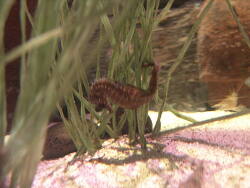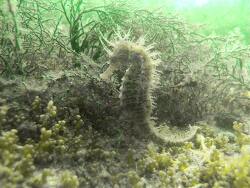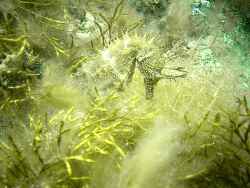Info
Cuvier, 1829
Synonyms:
Hippocampus bicuspis Kaup, 1856
Hippocampus filamentosus Duméril, 1870
Hippocampus guttulatus multiannularis Ginsburg, 1937
Hippocampus hippocampus microcoronatus Slastenenko, 1938
Hippocampus hippocampus microstephanus Slastenenko, 1937
Hippocampus longirostris Schinz, 1822
Hippocampus ramulosus Leach, 1814
Classification: Biota > Animalia (Kingdom) > Chordata (Phylum) > Vertebrata (Subphylum) > Gnathostomata (Superclass) > Pisces (Superclass) > Actinopterygii (Class) > Syngnathiformes (Order) > Syngnathidae (Family) > Hippocampinae (Subfamily) > Hippocampus (Genus) > Hippocampus guttulatus (Species)
Feeding intake.
The fish take a long time to eat at the beginning, before the food is taken up, a close inspection is carried out. After acclimatisation, the offered frozen food is eaten without problems. It should be noted that wild-caught fish behave differently than offspring when it comes to food intake. In the case of offspring, the size of the fish purchased also plays a role in the choice of food.
Synonyms:
Hippocampus bicuspis Kaup, 1856
Hippocampus filamentosus Duméril, 1870
Hippocampus guttulatus multiannularis Ginsburg, 1937
Hippocampus hippocampus microcoronatus Slastenenko, 1938
Hippocampus hippocampus microstephanus Slastenenko, 1937
Hippocampus longirostris Schinz, 1822
Hippocampus ramulosus Leach, 1814
Classification: Biota > Animalia (Kingdom) > Chordata (Phylum) > Vertebrata (Subphylum) > Gnathostomata (Superclass) > Pisces (Superclass) > Actinopterygii (Class) > Syngnathiformes (Order) > Syngnathidae (Family) > Hippocampinae (Subfamily) > Hippocampus (Genus) > Hippocampus guttulatus (Species)
Feeding intake.
The fish take a long time to eat at the beginning, before the food is taken up, a close inspection is carried out. After acclimatisation, the offered frozen food is eaten without problems. It should be noted that wild-caught fish behave differently than offspring when it comes to food intake. In the case of offspring, the size of the fish purchased also plays a role in the choice of food.







 AndiV
AndiV















































































